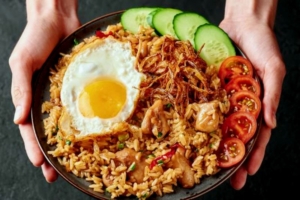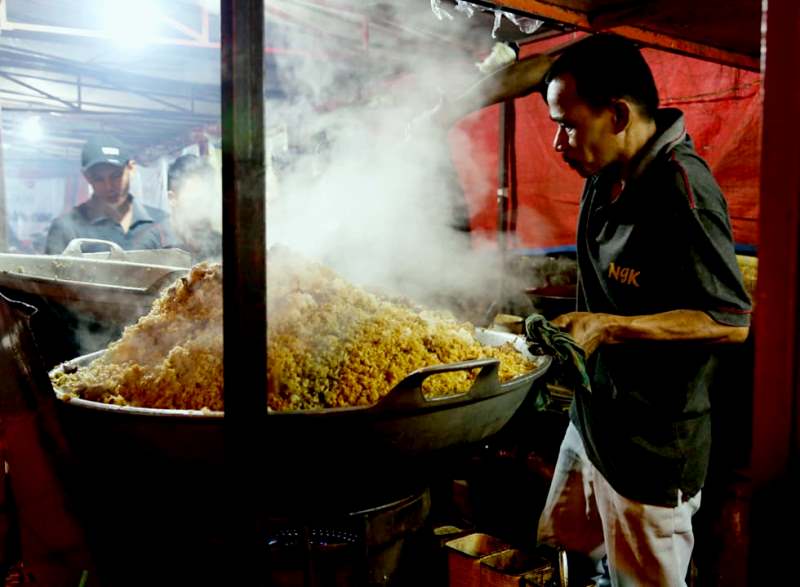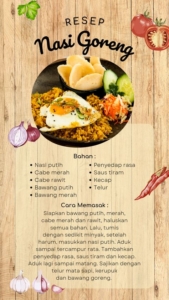How to Make Nasi Goreng (Nasgor) at Home
How to Make Nasi Goreng – If you’re a fan of fried rice dishes and looking to try something new, Nasi Goreng (nasgor) is the perfect recipe to add to your cooking repertoire. This Indonesian dish is packed with flavorful ingredients like spices, vegetables, and proteins, making it both delicious and satisfying. Plus, with our easy-to-follow guide, you’ll be able to whip up a batch of Nasi Goreng in no time.
NasGor is an abbreviation of Nasi Goreng and is usually spoken by Indonesians
- Nasi Goreng is a popular Indonesian dish that features fried rice and a blend of flavorful ingredients.
- This recipe is easy to make at home and can be customized to suit your preferences.
- Be sure to use the proper techniques for preparing the rice and layering the flavors to achieve the perfect balance.
- Add your favorite vegetables and proteins to make Nasi Goreng a complete and satisfying meal.
- Experiment with different garnishes and accompaniments to enhance the presentation and taste of your Nasi Goreng.
What is Nasi Goreng?
If you haven’t tried Nasi goreng yet, you’re in for a treat. Nasi goreng is a delicious Indonesian fried rice dish that’s characterized by its blend of sweet, salty, and savory flavors. The dish, which is traditionally made with leftover rice, is fried in oil and blended with a variety of ingredients, including fried shallots, garlic, and chilies. Vegetables, eggs, and proteins such as chicken, shrimp, or beef are also often added to the mix.
The term “Nasi goreng” literally translates to “fried rice” in Indonesian. It’s one of the most popular dishes in Indonesian cuisine and can be found in many street food stalls, restaurants, and homes throughout the country.
The dish has become so popular that it’s now enjoyed all over the world. In fact, Nasi goreng has been named one of the top 10 most delicious foods in the world by CNN Travel.

History of Nasi Goreng
Fried rice, also known as Indonesian fried rice, has a rich cultural history that dates back to ancient Indonesia. The dish originated as a way for Javanese street vendors to use up leftover rice from the previous day, by mixing it with spices and other ingredients to create a new dish.
Over time, fried rice evolved to become a beloved national dish in Indonesia, with regional variations that incorporate different ingredients and flavors. The dish was introduced to other parts of the world by Indonesian migrant workers, and today it is widely popular across the globe.
fried rice is not only a delicious meal but also a symbol of Indonesian culture and history, reflecting the country’s multicultural heritage and culinary traditions.
Read too: How To Cook Super Delicious Rendang Beef, Indonesian Style For Expatriates
Essential Ingredients for Nasi Goreng
Indonesian Nasgor is a flavorful and aromatic rice dish that packs a powerful punch of taste. To make an authentic Nasgor, you’ll need a combination of essential ingredients that come together to create a harmonious balance of flavors. Here are the must-have ingredients for making Nasi goreng at home:
| Ingredients | Description |
|---|---|
| Rice | A key element of Nasi goreng, the use of leftover cooked rice or freshly cooked white rice that has been cooled. |
| Shrimp paste | A pungent yet crucial ingredient that adds umami flavor to the dish. |
| Soy sauce | A staple in any Indonesian kitchen, soy sauce adds a savory and salty flavor to the dish. |
| Garlic and shallots | Aromatic ingredients add depth and flavor to the dish. |
| Chili peppers | Spice up your Nasgor with fresh or dried chili peppers, adding heat and flavor to the dish. |
| Vegetables | Common vegetables added to Nasgor include carrots, bell peppers, green beans, and peas. |
| Proteins | Meat, seafood, or tofu can be added to Nasgor to provide protein and additional flavor. |
| Oil | Use a neutral oil, such as vegetable or canola, to stir-fry the ingredients and add flavor to the dish. |
To achieve the perfect balance of flavors in your Nasgor, it’s important to use high-quality ingredients and cook them properly. With these essential ingredients and your newfound knowledge of Nasgor, you’re on your way to creating a delicious and authentic Indonesian meal in your kitchen.
Preparing the Rice for Nasi Goreng
The foundation of any good Nasi goreng is the rice. While it’s possible to use freshly cooked rice, leftover rice makes for an even better dish. The dry texture of leftover rice allows for it to absorb the flavors of the sauce and spices used in Nasi goreng, resulting in a more flavorful dish.
Begin by steaming your rice as you normally would. Once cooked, place it in a large flat container, preferably a shallow one, and allow it to cool. When the rice is at room temperature, use your hands to separate the grains, ensuring they don’t stick together.
Before you start frying the rice, it’s essential to let it air out for about an hour or so. This allows the rice grains to dry slightly, which helps to prevent the rice from becoming too sticky during the frying process.
When you’re ready to start frying, heat a generous amount of oil in a wok or frying pan. Once the oil is hot, add your rice, breaking up any clumps with a spatula. Fry the rice in the oil for several minutes, stirring often to prevent it from sticking to the pan.
Finally, add your seasonings and sauce to the rice, stirring well to distribute the flavors evenly. Fry the rice for a few more minutes, until it’s heated through and coated in a delicious layer of sauce. Your Nasgor is now ready to be served!

Building Flavors for Nasgor
One of the reasons Nasgor is such a beloved dish is because of its complex flavor profile. To achieve the perfect balance of sweet, salty, sour, and spicy flavors, it’s crucial to layer ingredients in a specific order.
Aromatics
The first step in building flavor for Nasi goreng is to sauté your aromatics in oil until fragrant. Aromatics such as garlic, onion, and ginger provide a strong base flavor and aroma.
Spices
Once your aromatics are fragrant, the next step is to add your spices. Turmeric, cumin, and coriander are popular additions to Nasi goreng and can provide a warm, earthy flavor. If you want a spicier Nasi Goreng, you can add chili powder or fresh chili peppers.
Sauces and Condiments
Condiments like soy sauce, fish sauce, and oyster sauce add a savory, umami flavor to the dish. Add these sauces to taste and be mindful of the salt content as you go. A splash of lime juice can also add a tangy kick.
Heat
If you want your Nasi goreng to have a spicy kick, a great way to build heat is by adding fresh sliced chili peppers. These small peppers also add texture and color to the dish. Be sure to remove the seeds from the peppers if you don’t want your dish to be too spicy.
Umami-Rich Ingredients
Finally, to round out the flavors of Nasi goreng, it’s important to include umami-rich ingredients. Vegetables like mushrooms or meats like shrimp, chicken, or beef can provide a flavorful addition to the dish. Don’t be afraid to experiment with different proteins and vegetables to find your perfect combination.
By layering these flavors in the right order, you can create a delicious and authentic Nasi goreng right at home.
Cooking Techniques for Nasi Goreng

Now that you have prepared all your ingredients, it’s time to start cooking your Nasi goreng. Here are some essential cooking techniques to keep in mind:
- Start by heating up your wok or frying pan until it’s hot.
- Add oil to your pan to prevent the rice from sticking.
- Add your aromatics, such as garlic and onions, and stir-fry until fragrant.
- Add your protein, such as shrimp or chicken, and stir-fry until cooked through.
- Push your ingredients to one side of the pan, and crack an egg in the empty space. Let it cook for a few seconds before mixing everything together.
- Add your rice to the pan and stir-fry until it’s heated through.
- Season with soy sauce, kecap manis, and any other sauces or spices.
- Continue stir-frying until everything is evenly coated and caramelized.
- Finally, add your vegetables and cook until they are tender but still crunchy.
Stir-fry your Nasi goreng quickly over high heat for best results. Be sure not to overcook the rice, as it can become mushy and lose its texture.
You can also customize your cooking techniques based on your preferences. For a smokier flavor, cook your Nasi goreng over a charcoal grill instead of a stove. Alternatively, for a healthier option, use less oil and opt for brown rice instead of white.
Adding Vegetables and Proteins to Nasi Goreng
Adding vegetables and proteins to your Nasi goreng is a simple way to create a complete and balanced meal. Traditional vegetables used in Nasi goreng include carrots, peas, and scallions, but feel free to experiment with other vegetables to suit your preferences. For an extra nutrient boost, add leafy greens like spinach or kale.
| Protein Options | Vegetable Options |
|---|---|
| Shrimp | Mushrooms |
| Chicken | Bean sprouts |
| Fish | Cabbage |
| Beef | Bell peppers |
In addition to traditional proteins like chicken, shrimp, pork, and beef, vegetarian and vegan options are perfect for plant-based eaters. For a meatless protein boost, try adding tofu, tempeh, or edamame to your nasi goreng.
When preparing your vegetables and proteins, it’s important to chop them into small, bite-sized pieces. This ensures that they cook evenly and meld well with the rice. For extra visual appeal and texture, finely chop some peanuts or cashews and sprinkle them on top of your Nasi goreng.
Adding vegetables and proteins not only enhances the nutritional value of your dish but also gives it a wide range of flavor and texture. Feel free to mix and match different ingredients to create your unique twist on this classic Indonesian dish.
Variations of Nasi Goreng
While fried rice is typically made with rice, eggs, vegetables, and protein, there are countless regional and cultural variations that incorporate different ingredients and flavors.
Here are a few examples of Nasi goreng variations:
| Variation | Description |
|---|---|
| Nasi Goreng Jawa | A Javanese version of the dish that includes sweet soy sauce, shrimp paste, and tamarind. |
| Nasi Goreng Pattaya | A Malaysian-style Nasi goreng wrapped in an omelette and served with chili sauce. |
| Nasi Goreng Ayam | A version of the dish that includes chicken as the protein source. |
| Nasi Goreng Ikan Asin | A seafood-infused variation that includes salted fish. |
| Nasi Goreng Babat | A spicy variation that includes tripe as the protein source. |
These are just a few examples, as the versatility of Nasi goreng allows for a wide range of delicious variations. Try experimenting with your ingredients and flavors to customize the dish to your liking.
Serving and Garnishing Fried Rice
Now that your fried rice is ready, it’s time to make it look as good as it tastes. Serving and garnishing your dish can elevate the experience and impress your guests. When serving Nasi goreng, consider using a traditional Indonesian platter or a simple white plate to showcase the vibrant colors and textures of your dish.
Top your fried rice with a fried egg, sliced chili peppers, and crispy shallots for an extra crunch. You can also add a side of prawn crackers or a cucumber and carrot salad to balance out the rich flavors and add a refreshing element to your meal. For a vegetarian option, substitute the protein with fried tofu or tempeh and garnish with fresh cilantro, chopped scallions, and lime wedges. Remember to serve your fried rice hot and fresh, allowing the aroma and complex flavors to shine through. Enjoy!
Nasi Goreng Menu Ideas
Looking to serve Nasi goreng as the centerpiece of a delicious meal? Here are some menu ideas that are sure to satisfy:
Classic Indonesian Spread
- Nasi goreng
- Chicken satay with peanut sauce
- Gado-gado (vegetable salad with peanut dressing)
- Tempeh or Tofu in Sweet Soy Sauce
- Sambal (chili paste condiment)
Seafood Feast
- Nasi goreng with shrimp and calamari
- Oyster Omelette (Or Chien)
- Steamed fish with ginger and soy sauce
- Assorted vegetable stir-fry
- Green Mango or Papaya Salad
Vegetarian Delight
- Nasi goreng with mixed vegetables and tofu
- Deep fried tempeh
- Stir-fried eggplant or Chinese Long Bean
- Gado-gado (vegetable salad with peanut dressing)
- Sambal (chili paste condiment)
Pair these dishes with a refreshing iced tea or a cold Indonesian beer to complete your fried rice menu.
Conclusion
Now that you’ve learned how to make delicious Nasi goreng at home, it’s time to give it a try! With just a few simple steps, you can enjoy this popular Indonesian dish anytime you want. Don’t be afraid to experiment with different ingredients and flavors to find your perfect version of Nasi goreng.
By understanding the history, essential ingredients, and cooking techniques, you’ve gained a deeper appreciation and knowledge of this beloved dish. Whether you’re a fan of spicy renditions or seafood-infused versions, there’s a Nasi goreng variation for everyone to enjoy.
So, get cooking and impress your family and friends with your newfound Nasi goreng skills. You’ll be surprised at how satisfying it is to create this flavorful dish yourself. And who knows, it may even become a regular part of your menu rotation!
Read too:
- Mie Ayam Street Food
- Indonesian Chicken Satay Recipes And Tips
- The Delicious World Of Martabak: Indonesian Treats
FAQ
How do I make Nasi Goreng at home?
(1) Cook the rice and let it cool.
(2) Heat oil in a wok or large skillet and sauté onions and garlic.
(3) Add diced vegetables and cook until tender.
(4) Push the vegetables to one side and crack an egg into the space. Scramble the egg and mix it with the vegetables.
(5) Add cooked rice to the wok and stir-fry, breaking up any clumps.
(6) Season with soy sauce, fish sauce, or other desired seasonings.
(7) Add protein such as cooked chicken, shrimp, or tofu if desired.
(8) Continue stir-frying until everything is well combined and heated through.
(9) Serve hot, garnished with sliced scallions, fried shallots, and a side of pickles.
What is Nasi Goreng?
fried rice is a popular Indonesian dish that refers to fried rice. It is typically made by stir-frying pre-cooked rice with a variety of ingredients, such as vegetables, meat, and aromatic spices. The dish is known for its savory and slightly sweet flavor, achieved through the use of ingredients like soy sauce, kecap manis (Indonesian sweet soy sauce), and shrimp paste. Nasi Goreng is often served with a fried egg on top and is a versatile and filling meal that can be enjoyed at any time of the day.
What is the history of Nasi Goreng?
Nasi Goreng has a rich history that dates back centuries in Indonesia. While the exact origins are unclear, it is believed to have been influenced by Chinese fried rice dishes brought by Chinese immigrants to the Indonesian archipelago. Over time, it has become a staple in Indonesian cuisine and has evolved to incorporate local ingredients and flavors. Nasi Goreng also showcases the cultural diversity and fusion of culinary traditions in Indonesia, making it a beloved and iconic dish in the country.
What are the essential ingredients for fried rice?
The essential ingredients for fried rice include cooked rice (preferably cold or leftover), onions, garlic, vegetables (such as carrots, peas, and bell peppers), protein (such as chicken, shrimp, or tofu), soy sauce, kecap manis (Indonesian sweet soy sauce), shrimp paste, and eggs. Optional ingredients can include chili paste, sambal oelek (Indonesian chili sauce), and various spices and herbs for added flavor.
How do I prepare the rice for Fried Rice?
To prepare the rice for fried rice, it is best to use cold or leftover rice that has been cooked and cooled. This helps to achieve the desired texture and prevents the rice from becoming mushy during the stir-frying process. If using freshly cooked rice, spread it out on a tray or baking sheet and let it cool completely before using it in the dish. If using leftover rice, break up any clumps and separate the grains with a fork before adding it to the wok or skillet.
How do I build flavors for Fried Rice?
To build flavors for fried rice, start by sautéing onions and garlic in oil to create a fragrant base. Add aromatic spices such as ground coriander, cumin, and turmeric to further enhance the flavors. Incorporate umami-rich ingredients like soy sauce, kecap manis, and shrimp paste for a savory taste. You can also add chili paste or sambal oelek if you prefer a spicy kick. Don’t forget to season with salt and pepper to taste and balance the flavors with a touch of sweetness from the kecap manis.
What are the cooking techniques for fried rice?
The cooking techniques for fried rice involve stir-frying the ingredients in a hot wok or skillet. Start by sautéing the onions and garlic, followed by adding the vegetables and protein. Push the cooked ingredients to one side, crack an egg into the space, scramble it, and mix it with the other ingredients.
Then, add the cooked rice and stir-fry, breaking up any clumps. Continue to stir-fry until everything is well combined and heated through. The aim is to achieve a slightly caramelized and smoky flavor while keeping the ingredients tender and flavorful.
How do I add vegetables and proteins to NasGor?
To add vegetables and proteins to NasGor, you can include a variety of diced vegetables, such as carrots, peas, bell peppers, and scallions. For proteins, you can use cooked chicken, shrimp, or tofu, depending on your preference. Simply add the vegetables and proteins to the wok or skillet with the other ingredients and stir-fry until they are cooked through. This allows the flavors to meld together, creating a balanced and satisfying dish.
What are the variations of NasGor?
NasGor has many variations, depending on the region and individual preferences. Some popular variations include Nasi Goreng Ayam (chicken Nasi Goreng), Nasi Goreng Seafood (seafood Nasi Goreng), Nasi Goreng Kampung (village-style Nasi Goreng), and Nasi Goreng Pete (Nasi Goreng with stinky beans). These variations often feature different combinations of proteins, vegetables, and seasonings, giving each version its unique flavor profile.
How should Nasgor be served and garnished?
NasGor is traditionally served hot and can be garnished to enhance the taste and presentation. Common garnishes include sliced scallions, fried shallots, and a side of pickles or cucumber slices. To elevate the dish further, you can add a fried egg on top, allowing the runny yolk to mix with the rice and enrich the flavors. Serve Nasi Goreng with additional condiments such as sambal oelek, soy sauce, or lime wedges to provide extra spice or tanginess, according to personal preference.
What are some NasGor menu ideas?
NasGor can be enjoyed on its own as a complete meal, or paired with complementary dishes and beverages. Consider serving Nasi Goreng with Indonesian-style satay skewers, peanut sauce, and a fresh salad for a balanced and satisfying meal.
You could also pair it with a side of Gado-Gado (Indonesian vegetable salad with peanut dressing), Krupuk (shrimp crackers), or Kerupuk Udang (prawn crackers) for added texture and flavor. As for drinks, options like traditional Indonesian iced tea (Teh Botol) or a refreshing tropical fruit juice would make great accompaniments.




